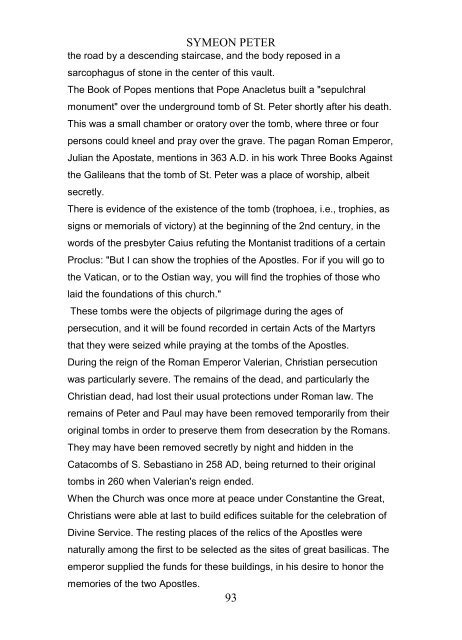Create successful ePaper yourself
Turn your PDF publications into a flip-book with our unique Google optimized e-Paper software.
SYMEON PETER<br />
the road by a descending staircase, and the body reposed in a<br />
sarcophagus of stone in the center of this vault.<br />
The Book of Popes mentions that Pope Anacletus built a "sepulchral<br />
monument" over the underground tomb of St. <strong>Peter</strong> shortly after his death.<br />
This was a small chamber or oratory over the tomb, where three or four<br />
persons could kneel and pray over the grave. The pagan Roman Emperor,<br />
Julian the Apostate, mentions in 363 A.D. in his work Three Books Against<br />
the Galileans that the tomb of St. <strong>Peter</strong> was a place of worship, albeit<br />
secretly.<br />
There is evidence of the existence of the tomb (trophoea, i.e., trophies, as<br />
signs or memorials of victory) at the beginning of the 2nd century, in the<br />
words of the presbyter Caius refuting the Montanist traditions of a certain<br />
Proclus: "But I can show the trophies of the Apostles. For if you will go to<br />
the Vatican, or to the Ostian way, you will find the trophies of those who<br />
laid the foundations of this church."<br />
These tombs were the objects of pilgrimage during the ages of<br />
persecution, and it will be found recorded in certain Acts of the Martyrs<br />
that they were seized while praying at the tombs of the Apostles.<br />
During the reign of the Roman Emperor Valerian, Christian persecution<br />
was particularly severe. The remains of the dead, and particularly the<br />
Christian dead, had lost their usual protections under Roman law. The<br />
remains of <strong>Peter</strong> and Paul may have been removed temporarily from their<br />
original tombs in order to preserve them from desecration by the Romans.<br />
They may have been removed secretly by night and hidden in the<br />
Catacombs of S. Sebastiano in 258 AD, being returned to their original<br />
tombs in 260 when Valerian's reign ended.<br />
When the Church was once more at peace under Constantine the Great,<br />
Christians were able at last to build edifices suitable for the celebration of<br />
Divine Service. The resting places of the relics of the Apostles were<br />
naturally among the first to be selected as the sites of great basilicas. The<br />
emperor supplied the funds for these buildings, in his desire to honor the<br />
memories of the two Apostles.<br />
93


















